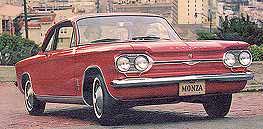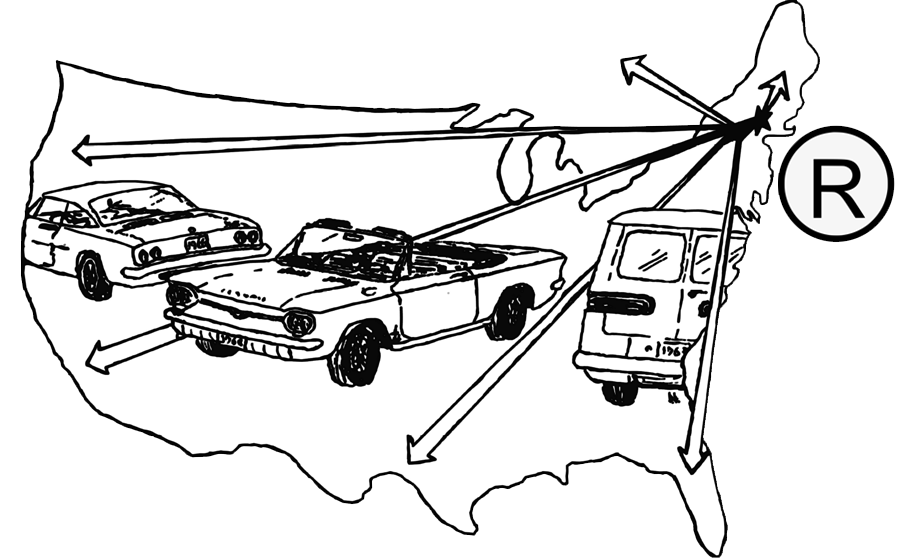| |
Home > Corvair History
| BRIEF CORVAIR HISTORY | The history of the Corvair starts when VWs started to be imported in larger and larger numbers during the mid '50s. At that time Chevrolet offered "full size Chevys", trucks and the Corvette-period. They wanted to offer "compact" cars by 1960 (as did just about every other manufacturer once they heard Chevy was coming out with a compact). Chevy may not have "copied" the VW but many of the basics of the air cooled rear engine, compact transaxle and suspension were similar; however,the Corvair was larger, inside and outside and was an "American size compact". The Corvair would represent several production firsts for Chevy including: their first (only) rear air cooled engine, first unitized body, first production car turbo, and fully independent suspension for each wheel-front and rear.
The 1960 Corvair was offered as a 2 door coupe & 4 door sedan in 2 trim levels and was honestly rather utilitarian. During the spring of 1960 a "sporty" Monza model was offered with full vinyl interior, bucket seats & full wheel covers. This sporty model was to really "drive" Corvair sales and attract the interest of enthusiasts in the coming years. Total 1960 production=250,007 |
| For 1961 Chevrolet added a 4 door station wagon, a window van (the Greenbrier), a panel van (Corvair 95), and a pickup (the Rampside) that had a side panel (ramp) that hinged down to the road. All vehicles had the rear air cooled engines which were now available with slightly more power. Even during this early period the Corvair was developing a following and was considered one of the "sportier" compacts, sometimes being referred to as a "poor man's Porsche". Total production=329,632. |
1962 saw major additions including: a convertible and the turbocharger option package. The option turbo included many changes - a few of those were: larger connecting rods,larger oil cooler, turbo & carb (horsepower increased from a max of 102hp to 150hp), chrome engine accents, special emblems, "Spyder" wheel cover inserts, special dash. Yes - this was the "Monza Spyder" option-available only on Monza coupes and convertibles with 4 speed transmissions. The Corvair now had power to go with its classic looks. Chevy placed many "sporty ads", often with the Corvette near by. Total production was 328,500.
By 1963 the station wagon was gone. There were minor changes in trim and interior but for the most part the car was identical to the 1962. Total production=281,539. |
 |
1964 was to be the last year of the "early" style ("boxy style"). It is also considered the best of the "early" styles for 2 reasons. First, Chevy had added a single leaf rear spring that went from the left rear lower suspension to the right lower suspension, attaching to the bottom of the differential in the middle - this spring carried about 40% of the rear weight & helped to control rear suspension "tuck in".
Secondly, the engine was increased to 164 cubic inches and the larger turbo connecting rods were made standard. The basic horsepower increased to 95, with optional 110. The Monza Spyder became an actual model instead of an option but was still rated as 150hp. This was the last year for the Rampside and Corvan 95. Total production decreased to 207,114 (Why? - the Chevy II came out in 1962, the Chevelle in 1964 and the Ford Mustang in 1964,but also - this was the 5th year of a car that looked basically unchanged since its introduction).
1965 was the first year of the "late style" - the "more modern style", that even today does not seem as "dated" as many cars from the mid '60s. There were numerous changes other than the obvious styling change. The basic engine remained the same 164 cubic inches and the base engines were 95hp and 110hp but you could also order a 4 carb-140hp engine in any model. The turbo option was now 180hp and could only be ordered in the Corsa (the Corsa came with a special dash and the 140 or 180hp engine). The rear suspension was now more like the Corvette and produced a major improvement in handling; however, most enthusiasts agree that the later body was never as "solid" as the "early" style. The coupe and 4 door had no center pillar when the windows were down (true "hardtops" in an "economy car"). Total production went up a little to 237,056. |
| 1966 was the last year for the turbo and Corsa model-the Greenbrier was discontinued after fewer than 2,000 were produced in 1965. The only major change in 1966 was the new Saginaw 4 speed transmission. Many feel that Chevy wanted to "drop" the Corvair when the 1967 Camaro was scheduled to come out but continued the car until 1969 so as not to appear that they were giving in to "consumer advocate claims". Total production =103,743. |
| 1967 - the Corsa was gone. This was the first year of the "skinny seats" and the last year for the 4 door. Chevy had "given up" on the Corvair, they now had their Camaro to fight the Mustang. There would be very little effort put into advertising.Total production=27,253. |
 |
1968-69 - more smog control,a few minor interior changes and the Corvair was gone - but not before 1,786,243 were produced and had won the hearts of many people. Total production, 1968=15,399 1969=6,000.
Please realize this is a very brief history - we sell some excellent books that give a detailed history of this American Classic.
Ralph Nader - The Corvair will probably always be linked to Ralph Nader's mid '60s book. Most of this book is not about the Corvair, but the Corvair received most of the attention. The majority of the controversy was about the rear suspension of the 1960-63 Corvairs. It was claimed that they would "tuck in" causing the car to go out of control & flip!! There was a film produced to show the Corvair going out of control-but it has been contended that "tricks" were used to get the Corvair to finally lose control. GM hired race drivers and other experts to prove that the Corvair was safe and the general conclusion was that it was as safe (if not safer) than most cars of the time. The final report by the National Highway Safety Administration was not given until 1972. The Corvair "won" - but it was too late and received little space in the news of the day.
What "killed the Corvair"? Most people assume that Mr. Nader's book and the court cases did,but they were not the main cause. The main reasons? Cheap gas and cheap horsepower. Remember the muscle cars? The GTO, Mustang, Camaro, etc? The Corvair was always expensive to build and was limited by engine size. For a few hundred $ more you could have a muscle car and who cared since high test gas was only about .34 a gallon. Consumers wouldn't care about gas consumption until the first gas crisis of the early 1970's. The Corvair, the Falcon and most "economy cars" were mostly gone by 1969. Chevy didn't need it - they had the Chevy II, the Camaro and the Chevelle - all available with big V8s. |
|







